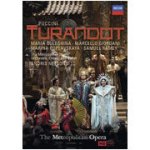When this Franco Zeffirelli production of Turandot was new in 1987 it caused great consternation, admiration, laughter, and headaches. Never, even at the Met in a Zeffirelli production, were such dazzling colors, brilliant lights, and so many busy supernumeraries visible on stage. In fact, it was hard to find most of the main players/singers. The crowd was so gigantic that they were cramped to the footlights; almost no one could move. But at least this opera’s grandeur made and makes more sense than Zeffirelli’s entertaining but bloated La bohème, his appalling Traviata, and his why-bother-visiting-Rome Tosca. Not to mention his Cavalleria rusticana, which one observer called “the greatest poverty-stricken Sicilian village money can buy.”
Recorded on November 7, 2009, this 22-year-old extravaganza has lost none of its razzle-dazzle. In Act 1 there are red dragons wandering about, a bevy of bare-chested, sword-wielding executioner/soldiers, lantern-lit bridges, hundreds of extras racing or milling about in shades of blue and gray, bamboo-like staircases going every which way, and a sudden appearance of Turandot herself, combing her hair while floating above stage rear. And that’s Act 1, the under-decorated act.
The costumes of Ping, Pang, and Pong are such lavish creations in colorful, heavy brocade that they must be very highly paid indeed. The gold and silver throne room with ivory walls and bridges over fake reflecting pools in Act 2 actually can hurt your eyes. During the Riddle Scene, as Calaf gets each answer right, courtiers pull acres of streaming fabric out of poles behind Turandot: is she unraveling? (We might wonder in general about the omnipresence of twirling fabric in this production.)
The whole event suffers from giganticism–in the opera house you can’t take it all in under any circumstances, and so much of it seems unnecessarily busy and showy. Perhaps home viewing is the best route–when soloists sing, the camera zooms in on them; otherwise we get enough intelligent panning to feel like we’re on a walking tour of Peking.
This production has been recorded for small screen before–in 1988 with Eva Marton and Placido Domingo–but I guess HD has its fans and so this set was deemed necessary. It’s a high-camp feast for the undiscerning eye; it gives you your money’s worth. Costume designers Anna Anni and Dada Saligeri are to be acknowledged for both their nerve and creativity; set designs are by Zeffirelli.
The invariably unsubtle Maria Guleghina is our Turandot, and I must begrudgingly acknowledge that she’s in her best voice, neither flatting nor sharping (much), holding back as best she can in tender or private passages, and acting as well as any Turandot ever does. Her transformation in the last act is dramatically convincing and she is absolutely tireless. All-purpose tenor Marcello Giordani turns in a good enough Calaf, his high notes ringing bright and true, his lower register almost non-existent (thereby keeping the top lively and present?), and his characterization standard. Reliable and uninteresting, I fear. Samuel Ramey’s Timur is a shadow of its former self; he is still imposing but his voice has developed a severe wobble.
The stars of the evening are conductor and second soprano. Marina Poplavskaya has impressed at the Met as Elisabetta and Violetta, and as Liu she is no less effective. She acts convincingly, looks wonderful, and sings with great warmth and sure technique, including some lovely pianissimos. Latvian conductor Andris Nelsons knows bombast when he sees it and rises to each occasion, but he also pays heed to Puccini’s delicate colorations elsewhere: the choral passage of dead lovers in Act 1 is mysterious and otherworldly. And all of the ensembles hold together, played and sung gloriously by the Met forces.
Intermissions treat us to a moment or two of stagehands moving furniture, and later, soprano Patricia Racette briefly interviews Guleghina and Giordani, who praise one another and offer no insights. Then out comes tenor Charles Anthony, who sings Turandot’s father, Altoum, to reminisce about his 56 years and more than 2,800 performances at the Met. He retired, incidentally, in January, 2010. Picture is brilliant and, as mentioned, camera work is helpful. There are subtitles in English, French, German, Spanish, and Chinese.
The competition is not great; one is startled by the number of garish and not-well-sung performances of this opera. If you love Zeffirelli, then you may as well get the previous recording of this production, starring an uncharismatic but quite imposing Eva Marton and Placido Domingo as Calaf. Ghena Dimitrova is cut from a similar noisy cloth as Guleghina on Kultur; Carreras is overparted on Arthaus; Gabriele Schnaut, under Gergiev from Vienna on TDK, sings the ending completed by Luciano Berio–and sings it quite poorly, I might add. An old black and white film starring Franco Corelli and Lucille Udovich is fun, lip-synched, and sui generis. An underrated performance by soprano Luana DeVol from Barcelona on TDK is beautiful to look at but has mediocre co-stars. In other words, it’s Marton/Domingo as first choice.
































